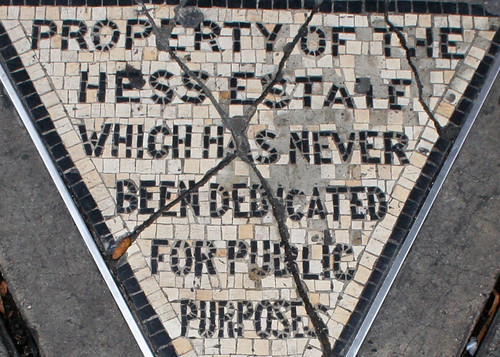One of my favorite bits of unusual New York City history is located on the sidewalk in front of West Village’s iconic Village Cigars store. It’s pretty well known, but I’m going to re-tell it because it’s such a great story.
Set into the sidewalk is a small triangle (see my sneaker for size comparison), with the mysterious message: “Property of the Hess Estate Which Has Never Been Dedicated For Public Purposes.”
In 1910, the area around Christopher Street and Seventh Avenue was being widened by the city. Over 300 buildings were condemned and razed under Eminent Domain laws, including a 5-story apartment building called The Voorhis belonging to David Hess.
Hess fought the city fiercely to save his building but lost, and by 1914, this small triangle was all that was left of his property. Thinking he’d been suitably beaten down, the city asked Hess to voluntarily donate the minuscule triangle for use as part of the public sidewalk – but Hess refused, and had this mosaic installed on July 27, 1922. Though it inevitably became part of the sidewalk anyway, anyone who walked over the triangle couldn’t help but be reminded of Hess’ battle.
The sign hasn’t been chanced since. In 1938, Hess sold the triangle of land to the cigar store for $1,000, and thankfully, the mosaic was left alone, cracks and all. I love seeing it walking through the Village, a reminder that sometimes the little guys win in ways you can never imagine.
-SCOUT




I wondered what that was about when I saw it last year!
I have walked past that spot thousands of times and never noticed it. Thank you so much for paying attention.
yikes!
That’s a fun story, but it’s too bad that he ended up selling the land. And even though it’s New York, wasn’t $1000 a lot of money back in 1938 for such a tiny piece of land?
I’ve probably stepped on that triangle a hundred times without realizing the interesting story behind it! What a great post, especially considering the current Eminent Domain issues in <West Harlem.
Love this website!
This has always been one of my favorite pieces of NYC trivia. Thanks for featuring it!
Nice! This is a classic stop on the Travelgoat West Village tour. We also walk around the corner on Christopher Street in what is now a salon, to the secret door that was a stop on the underground railroad.
Weren’t those buildings condemned to create 7th Ave. South (which didn’t exist before then but had to be created to construct the IRT subway line using the “cut and cover” method then in use for subway construction)?
This is correct. Seventh av used to end at Greenwich Ave. The cut to Varick st was made in 1913 so the subway company didn’t have to spend big on expensive drilling, instead they convinced the City to demolish anything in the path of the new Seventh Av South so they could use the cheaper ‘open cut’ method. Incredible, huh?!
Hess’ building was entirely condemned – all but that 50 square inch plot in front of the cigar shop, so he insisted on maintaining it as private property – probably as revenge for ‘the cut’!
Do you know how big the triangle of land is that the cigar store sits on? Great piece of trivia, BTW.
Web design NJ company.Search engine optimization. Internet advertising agency. Development and promotion of websites in New Jersey. web design
You gotta get this right; Seventh av used to end at Greenwich Ave. The cut to Varick st was made in 1913 so the subway company didn’t have to spend big on expensive drilling, instead they convinced the City to demolish 9 city blocks worth of buildings – churches, businesses and apartments – anything in the path of the new Seventh Av South so they could use the cheaper ‘cut and cover’ method. Incredible, huh?!
Hess’ building was entirely condemned – all but that 50 square inch plot in front of the cigar shop, so he insisted on maintaining it as private property – probably as revenge for ‘the cut’! Seventh Av south has never been widened. It’s exactly the width the subway company wanted!
Cheers,
Tim
Hi there friends, its impressive piece of writing about teachingand completely defined, keep it up all the
time.
I loved this piece of information. Something really unique and interesting. I think this piece of land is worth much more than $1000 now. 🙂
I have been there many times and we used to walk around this Village Cigars store.